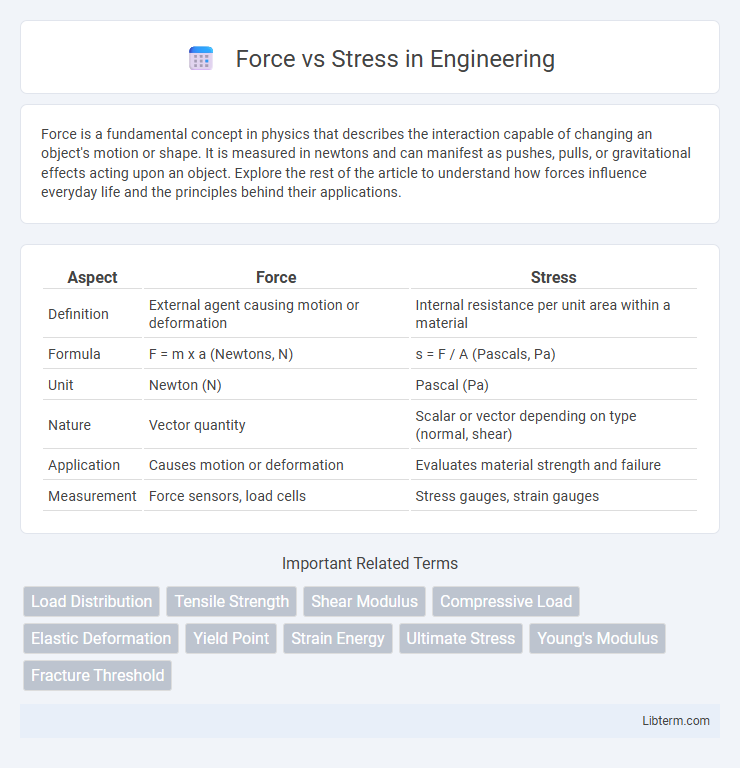Force is a fundamental concept in physics that describes the interaction capable of changing an object's motion or shape. It is measured in newtons and can manifest as pushes, pulls, or gravitational effects acting upon an object. Explore the rest of the article to understand how forces influence everyday life and the principles behind their applications.
Table of Comparison
| Aspect | Force | Stress |
|---|---|---|
| Definition | External agent causing motion or deformation | Internal resistance per unit area within a material |
| Formula | F = m x a (Newtons, N) | s = F / A (Pascals, Pa) |
| Unit | Newton (N) | Pascal (Pa) |
| Nature | Vector quantity | Scalar or vector depending on type (normal, shear) |
| Application | Causes motion or deformation | Evaluates material strength and failure |
| Measurement | Force sensors, load cells | Stress gauges, strain gauges |
Understanding Force: Basic Concepts
Force is a vector quantity that describes the interaction between objects, causing changes in motion or shape, measured in newtons (N). It acts at a point and can be categorized as contact forces, like friction and tension, or non-contact forces, such as gravity and electromagnetic forces. Understanding force involves analyzing its magnitude, direction, and point of application to predict mechanical behavior and response in physical systems.
Defining Stress in Materials
Stress in materials refers to the internal force exerted per unit area within a solid object when subjected to external loading, typically measured in pascals (Pa). It quantifies the intensity of internal forces that develop in response to applied forces, indicating how a material resists deformation or failure. Understanding stress distribution is crucial for predicting material behavior under various load conditions and ensuring structural integrity.
Key Differences Between Force and Stress
Force is a vector quantity representing the interaction that causes an object to accelerate, measured in newtons (N), while stress is a scalar or tensor quantity defined as force per unit area within materials, measured in pascals (Pa). Stress quantifies internal resistance to deformation, whereas force is the external cause that produces such deformation. Understanding that force acts on a body and stress exists within a material is crucial for analyzing mechanical behavior and structural integrity.
Units and Measurement of Force
Force is quantified in newtons (N), where one newton equals the force needed to accelerate a one-kilogram mass by one meter per second squared (1 N = 1 kg*m/s2). Stress measures force distribution over an area, expressed in pascals (Pa), which is one newton per square meter (1 Pa = 1 N/m2). Accurate force measurement involves devices like load cells and force sensors calibrated to the newton unit for precise engineering and scientific analysis.
Units and Measurement of Stress
Force is measured in newtons (N), representing the push or pull on an object, while stress quantifies the internal resistance per unit area within a material, measured in pascals (Pa). Stress is calculated by dividing the applied force by the cross-sectional area (square meters, m2) over which the force acts, resulting in units of N/m2 or Pa. Precise measurement of stress is essential in engineering and material science to predict material behavior under load and prevent structural failure.
How Force Causes Stress
Force causes stress by exerting pressure on a material's internal structure, leading to deformation or strain. Stress is quantitatively defined as the force applied per unit area within materials, typically measured in Pascals (Pa). Understanding the relationship between applied force and resulting stress is crucial for predicting material behavior and ensuring structural integrity in engineering applications.
Practical Examples: Force vs Stress
Force refers to the push or pull acting on an object, measured in newtons (N), such as lifting a 10 kg weight requiring approximately 98 N of force due to gravity. Stress, defined as force per unit area (N/m2 or Pascals), occurs when this force is distributed over the cross-sectional area of a material, for example, a metal rod experiencing stress when a load is applied to its surface. Practical engineering applications analyze stress to ensure materials withstand forces without deforming, like calculating the stress on a bridge cable supporting a known force to prevent structural failure.
Mathematical Relationship Between Force and Stress
Stress is mathematically defined as the internal force (F) acting per unit cross-sectional area (A) within a material, expressed as s = F/A. This relationship indicates that stress increases proportionally with the applied force and inversely with the area over which the force is distributed. Analyzing stress is critical in engineering and materials science to predict material behavior under varying loads.
Real-World Applications of Force and Stress
Force in real-world applications often manifests in mechanical systems like engines and bridges where it causes motion or deformation, while stress quantifies the internal resistance within materials under these forces. Engineers analyze stress distributions to ensure structural integrity in buildings, aircraft, and automotive components, preventing failure under operational loads. Understanding the relationship between applied force and resulting stress is critical for designing materials and structures that withstand dynamic forces in aerospace, civil engineering, and biomechanics.
Common Misconceptions About Force and Stress
Force is often mistakenly equated with stress, but force refers to an external push or pull acting on an object, while stress is the internal resistance per unit area developed within materials under force. A common misconception is assuming stress is a force rather than understanding it as a measure of how force is distributed internally over a cross-sectional area. Stress depends on both the magnitude of the applied force and the material's geometry, often leading to confusion when interpreting mechanical behavior in engineering contexts.
Force Infographic

 libterm.com
libterm.com